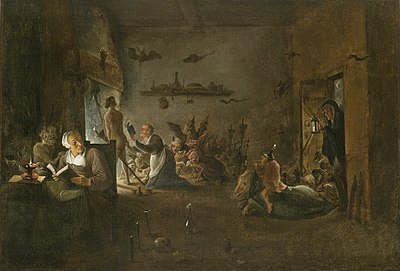| This article needs additional citations for verification. Please help improve this article by adding citations to reliable sources. Unsourced material may be challenged and removed. Find sources: "Besom" – news · newspapers · books · scholar · JSTOR (April 2010) (Learn how and when to remove this message) |
 Classic form of the besom
Classic form of the besom alternative form of the besom, using fibres instead of twigs
alternative form of the besom, using fibres instead of twigs

A besom (/ˈbiːzəm/) is a broom, a household implement used for sweeping. The term is mostly reserved for a traditional broom constructed from a bundle of twigs tied to a stout pole. The twigs used could be broom (i.e. Genista, from which comes the modern name "broom" for the tool), heather or similar. The song "Buy Broom Buzzems" from Northern England refers to both types of twig. From the phrase broom besom the more common broom comes. In Scotland and Bulgaria, besoms are still occasionally to be found at the edge of forests where they are stacked for use in early response to an outbreak of fire.
Description
As a result of its construction around a central pole, the brush of the besom is rounded instead of flat. The bristles can be made of many materials including, but not limited to straw, herbs, or twigs. Traditionally, the handle is of hazel wood and the head is of birch twigs. Modern construction uses bindings of wire and string (instead of the traditional split withy) and the head is secured by a steel nail instead of a wooden dowel.
Cultural associations
Besoms and flying ointments in early modern witchcraft
Main article: Flying ointment


A number of different recipes for "flying ointments" have survived from the early modern period, some of the constituents of which not only have hallucinogenic properties but are fat-soluble and could have been absorbed transdermally. Certain researchers have speculated that the stereotypical image of the witch "flying" astride the broomstick of a besom may derive from traditions concerning the use of broomsticks or other staves by women to apply psychotropic ointments to their vaginal or anal mucosa. The active ingredients in flying ointments were primarily plants in the nightshade family Solanaceae, most commonly Atropa belladonna (deadly nightshade) and Hyoscyamus niger (henbane), belonging to the tropane alkaloid-rich tribe Hyoscyameae. Other tropane-containing, nightshade ingredients included the famous mandrake (Mandragora officinarum), Scopolia carniolica and Datura stramonium, the thornapple. The alkaloids atropine, hyoscyamine and scopolamine present in these solanaceous plants are not only potent (and highly toxic) hallucinogens of the deliriant class, but are also fat-soluble and capable of being absorbed through unbroken human skin. Another ingredient listed frequently in the various flying ointment recipes is the even more toxic Aconitum napellus, which has (among others) the English common name wolfsbane (i.e. "slayer of wolves").
In Russia and Ukraine

In Russian culture, the besom or venik (Russian: веник) has historically had both good and bad connotations. It was seen as a place behind or under which a domovoy would hide, and similarly to the broom it was sometimes associated with the occult. However, it also sometimes served as a protective amulet, as well as a tool for fortune-telling. A venik was also often not thrown away, instead being ceremonially burned during Maslenitsa. The venik's cultural significance extends outside Russia: in Odesa Oblast, Ukraine, a large venik statue (six metres tall) was erected to commemorate the 620th anniversary of the foundation of Savran, a settlement in the area, which was recognized as the largest venik monument in the world.
See also
- Kumade rake
- Jumping the broom
References
- ^ Hansen, Harold A. The Witch's Garden pub. Unity Press 1978 ISBN 978-0913300473
- Adams, Cecil (September 3, 1999). "What's the deal with witches and broomsticks?". Retrieved 3 March 2012.
- ^ Harner, Michael J., Hallucinogens and Shamanism, pub. Oxford University Press 1973, reprinted U.S.A.1978 Chapter 8 : pps. 125–150.
- Hunziker, Armando T. The Genera of Solanaceae A.R.G. Gantner Verlag K.G., Ruggell, Liechtenstein 2001. ISBN 3-904144-77-4.
- Schultes, Richard Evans; Albert Hofmann (1979). Plants of the Gods: Origins of Hallucinogenic Use New York: McGraw-Hill. ISBN 0-07-056089-7.
- Sollmann, Torald, A Manual of Pharmacology and Its Applications to Therapeutics and Toxicology. 8th edition. Pub. W.B. Saunders, Philadelphia and London 1957.
- ^ "Веник". Российский гуманитарный энциклопедический словарь (in Russian). Vol. 1. St. Petersburg: Гуманитарный издательский центр ВЛАДОС. 2002. ISBN 5-8465-0021-8. Archived from the original on 2023-10-26.
- "«Самый большой в мире веник» сплели в Одесской области (ФОТО)". Одесская Жизнь (in Russian). 2018-09-29. Retrieved 2022-05-12.
External links
- "Besom" . Encyclopædia Britannica (11th ed.). 1911.
| Magic and witchcraft | |||||||||||||||||
|---|---|---|---|---|---|---|---|---|---|---|---|---|---|---|---|---|---|
| Types |
| ||||||||||||||||
| Practices | |||||||||||||||||
| Objects | |||||||||||||||||
| Folklore and mythology | |||||||||||||||||
| Major historic treatises |
| ||||||||||||||||
| Persecution |
| ||||||||||||||||
| In popular culture | |||||||||||||||||
| Related | |||||||||||||||||
